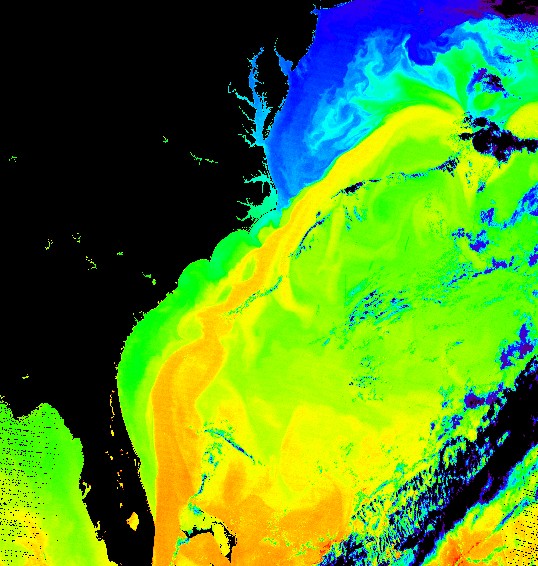How Will Climate Change Impact the Gulf Stream?
Evidence suggests that this major ocean current, which influences the weather in parts of Europe and the U.S., is already changing.
“You Asked” is a series where Earth Institute experts tackle reader questions on science and sustainability.
The following question was submitted through our Instagram page by one of our followers. The answer was provided by Arnold Gordon.
How will the Gulf Stream be impacted by climate change, and what are the impacts of that change on Europe?

The Gulf Stream is a very strong current pressed up against the east coast of the United States. It brings warm water from the Gulf of Mexico into the North Atlantic, and it’s driven by the winds over the Atlantic. It carries a lot of water: about 80 million cubic meters of water per second near Cape Hatteras in North Carolina. A cubic meter is about the amount of water in a bathtub, so there’s about 80 million bathtubs of water per second flowing through that section.
After leaving Cape Hatteras, the Gulf Stream crosses the Atlantic Ocean, with some of its waters turning south in the eastern Atlantic, and some turning towards the north. The latter branch serves as a major heat source for the weather and climate of Western Europe. Great Britain and Scandinavia would be a lot colder if it weren’t for the Gulf Stream.
It affects weather in the U.S., too. By bringing so much warm water along the mid-Atlantic and southeastern states, it adds some warmth to the eastern coast of the U.S. The Gulf Stream also affects the paths of hurricanes, and their strength — they intensify as they draw up the heat from the warm water. So factoring in the Gulf Stream is essential in predicting hurricanes heading toward the U.S.

The Gulf Stream gets stronger or weaker as part of the natural forces of climate variation. But under human-induced climate change, the Gulf Stream is predicted to get weaker — it will flow more slowly and carry less water. And there is some evidence, from measurements made over many decades, that it is indeed getting slightly weaker. For example they’ve been measuring the Gulf Stream from a satellite, and there are some indications that it has been weakening since the early 1990s. There was also a paper published recently in Scientific Reports that found that the Gulf Stream is not only weakening, but it might be shifting to the south. We cannot say for sure that these changes are caused by anthropogenic climate change, but the Gulf Stream does seem to be weakening and changing its course, which is what we might expect from such climate change.
Impacts of a Changing Gulf Stream
The weakening of the Gulf Stream might be tied to less heat reaching Northwest Europe, and more severe winter weather in that region.
This is mainly because of a slowing down of the part of the Gulf Stream feeding into the Atlantic Meridional Overturning Circulation (AMOC). Normally, as the Gulf Stream passes Great Britain, reaching the latitudes of Scandinavia and the Greenland and Norwegian Seas, the water cools and becomes denser. It then sinks, returning to the south at depths greater than 2000 meters, in what is referred to as North Atlantic Deep Water, the lower limb of AMOC. This sinking motion draws more warm Gulf Stream water toward Great Britain and Scandinavia.
Many models show that anthropogenic climate change induces a slowdown of AMOC, due to more precipitation and glacial melt in Norwegian and Greenland Seas. This addition of freshwater makes the surface water less dense, which makes it less prone to sinking into the deep ocean. If that’s right — if we get a slowdown of the sinking in the North Atlantic — then less of the Gulf Stream is going to turn northward toward Northwestern Europe. If AMOC and the Gulf Stream do become weaker, the probability is that Northwest Europe is going to get cooler, or not warm as much as it otherwise would under global anthropogenic climate change.
As for the U.S., sea level is rising off the northeastern and mid-Atlantic states, and part of it is driven by the weakening of the Gulf Stream. The other part is of course the melting of glaciers from Greenland and Antarctica, which is by far going to be more and more important. The potential for that sea level rise is tens of meters, whereas the potential for sea level rise from the weakening Gulf Stream is just 10 centimeters.
Still, 10 centimeters can be significant. That’s a few inches, so it’ll make the coastal flood impact of hurricanes greater. Climate change is supposed to make hurricanes more intense, which means we’re going to get stronger winds, and stronger winds will push seawater up against the coast when the hurricane hits. And if sea level is a little bit higher, maybe because of the Gulf Stream weakening, it only makes matters worse. It’ll contribute to a greater incidence of flooding along the coast.
However, the Gulf Stream slowing up is going to be a rather minor part of the dangers of climate change, in my opinion. The thing that I would worry about is that extreme weather events are going to become more commonplace. We’re going to see wet areas get wetter, and dry areas get drier. The deserts are going to expand toward the poles in both hemispheres. Hurricanes are going to get stronger, and weather extremes will be more common.
And then over the longer-term, over decades and centuries, the big concern is extreme increase in sea level because of glacial melt. By 2100, we’re going to see a sea level change of one or two meters. In centuries to come, sea level would rise by more than 10 meters, and that’s going to be disastrous.
So those things worry me. Climate change is so severe that it’s much easier not to think about it, like an ostrich with its head in the sand. But it’s so important that society tries to come to terms with climate change, to fix it or adapt to it — or both. It’ll be a big job. It is possible, but it really has to be done soon before it becomes irreversible.
